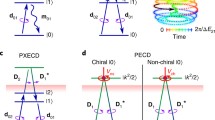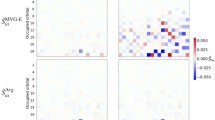Summary.
The first part of the present communication develops the general theory of the partial optic axis, which is an excitation specific structural feature first proposed as an aid to the choice of chromophoric reference points in a molecular exciton approach to optical rotatory power, and discusses its applicability to symmetry analyses in the light of the distinction between the three categories for anisotropic optical rotatory power, i.e. chiral, achiral optically active, and achiral optically inactive molecular structures. The second part of the communication discusses the special role played by the concept of the partial optic axis in the evaluation of the anisotropic chromophoric intensity contributions in a molecular exciton approach, in particular in relation to the use of the chromophoric symmetry for the systematic selection and characterization of the intensity contributions.
Similar content being viewed by others
Author information
Authors and Affiliations
Corresponding author
Additional information
Permanent address: Holmebjerg 5, DK-2950 Vedbæk, Denmark
Rights and permissions
About this article
Cite this article
Hansen, A. Molecular Exciton Approach to Anisotropic Absorption and Circular Dichroism II. The Partial Optic Axis and its Application in Molecular Exciton Theory. Monatshefte für Chemie 136, 275–287 (2005). https://doi.org/10.1007/s00706-005-0284-0
Received:
Accepted:
Published:
Issue Date:
DOI: https://doi.org/10.1007/s00706-005-0284-0




